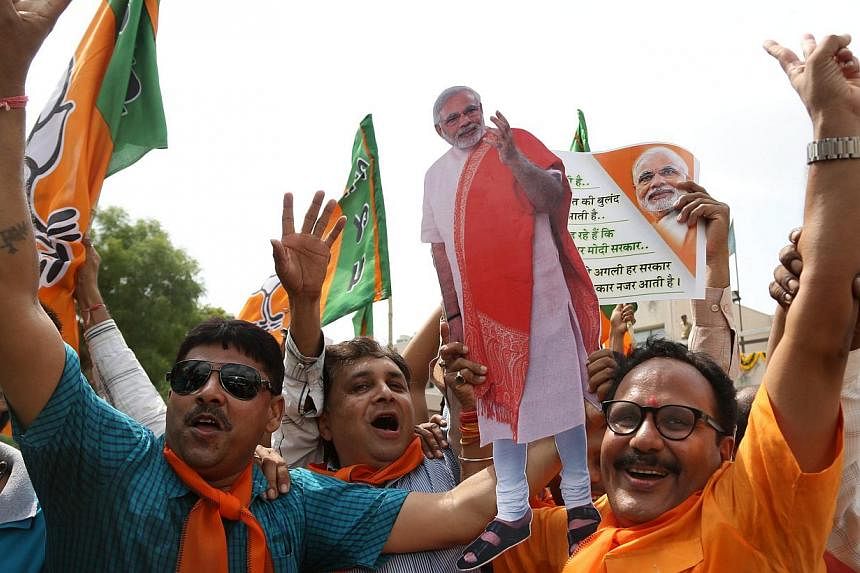NEW DELHI - The Bharatiya Janata Party (BJP) was on its way to a simple majority on its own in India's general election, according to the latest trends in what would be the strongest ever electoral performance by a national party in almost three decades.
That would set BJP's pro-business prime ministerial candidate Narendra Modi to be the next prime minister of India, sending Indian markets got off to a roaring start on Friday. The rupee broke below 59 to the US dollar, an 11-month high, and the benchmark stock index jumped 6 per cent to a record 25,375.63 before paring its gains.
Coalition politics have dominated the country's politics for decades, with no single national party in the last 30 years reaching a majority of 272 seats in a 543-seat Parliament.
In the latest trends, the party was leading in 275 seats with a clean sweep expected in the capital city of Delhi, Rajasthan, Gujarat and Uttarakhand and a strong showing in the politically key states of Uttar Pradesh and Bihar, which together account of 120 seats in Parliament.
The party was also making its presence felt in the southern states like Andhra Pradesh and Kerala where it had won no seats in previous elections.
The BJP-led alliance was leading in 323 seats in what Indian television channels were describing as a "BJP tsunami".
As the trends continued to pour in, wild celebrations broke out in the BJP even as gloom descended on the Congress party, which is headed for a humiliating defeat.
Senior BJP leader Mukhtar Abbas Naqvi was seen drumming the dhol, an Indian drum, as celebrations broke out at the BJP headquarters in Delhi where sweetmeats like ladoos were being rolled out to mark the return of the party, which has been in opposition for a decade.
BJP patriarch L K Advani and party president Rajnath Singh congratulated Mr Narendra Modi, the chief minister of the state of Gujarat who energised the BJP campaign after he was named the party's prime ministerial candidate in September 2013 and is instrumental to the current saffron, the colour of the party, wave in the country.
The ruling Congress was leading in around 58 seats according to the latest trends with its leaders conceding on television channels that it was time for serious introspection within the party, which has dominated Indian elections since Independence in 1947.
Congress vice-president Rahul Gandhi, who headed the campaigning for the Congress, was in a battle to retain his own seat of Amethi, a Gandhi family borough, where BJP candidate Smriti Irani and Aam Aadmi Party's Kumar Vishwas were seen to have had some impact.
In Amethi, a few Congress supporters shouted slogans in favour of Mr Gandhi's sister Priyanka in one of the first signs of anger and frustration against the Congress vice president who was in charge of the party's country wide campaign.
But the man of the moment, Mr Modi, was leading from both the seats of Vadodara in his home state of Gujarat and Varanasi in the central state of Uttar Pradesh.
Regional parties Ms Jayaram Jayalalithaa, the 66-year-old chief of the southern party All India Anna Dravida Munnetra Kazhagam, and Mr Naveen Patnaik, 67, leader of the Biju Janata Dal, were both headed for a sweep in the states of Tamil Nadu and Odisha respectively.
The Election Commission started tallying votes from 1.8 million Electronic Voting Machines across 989 counting centres.
The EVM machines, which were kept under tight security, were unsealed one by one as the votes of over 500 million people were being counted in what has been the biggest democratic exercise in the world
Exit polls had predicted the Bharatiya Janata Party would come to power, ending a decade of Congress rule which was characterised in its second five year term by a series of corruption scandals and poor governance as the country's fast paced economic growth slowed to below five per cent.
India's massive electoral process started off on April 7 and concluded five weeks later on May 12 in a nine phase election with over 814 people eligible to vote.
A record was set with a 66 per voter turnout besting a record of 64 per cent set in 1984 when voters moved by the assassination of sitting Prime Minister Indira Gandhi came out in large numbers to vote.
In a US style presidential style election Mr Modi dominated the election discourse rolling out a massive publicity campaign promising ``good times ahead" if his government came to power.
The Congress, which had been in power for a decade, was unable to match up to the BJP's campaign with the electoral discourse descending to name calling by the top leaders.
Mr Modi took potshots at the Gandhi dynasty and called Mr Gandhi princeling while Mr Gandhi criticised Mr Modi for failing to take care of his wife from whom he had separated decades ago.
These elections were also characterised by a large number of young voters with 100 mililon youngsters exercising their franchise for the first time.
All political parties, including traditional regional parties, made an effort to woo the young by taking their campaigns beyond road shows and public meetings on to social media websites like facebook and twitter.

